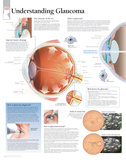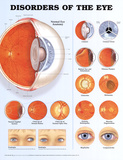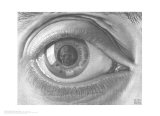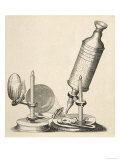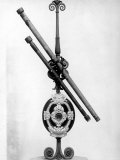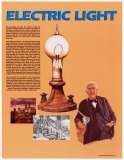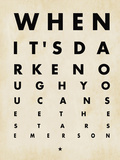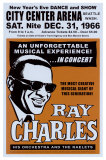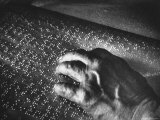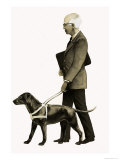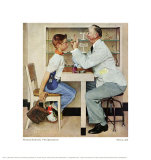|
|
Vision & Eyes Anatomy Posters & Charts
for science classrooms, homeschoolers and professional offices.
|
science > biology > anatomy > EYES < health posters
|
|
Sight is the detection of electromagnetic energy in the visible range by the eye, the organ of sight, and the brain to intrepret the light signals. Did you know that red has the longest wavelength of light discernible to the human eye?
Eyes of arachnid, fish birds, cat, dog, elephant, horse and more ...
• “In the kingdom of the blind, the one-eyed man is king.” Desiderius Erasmus
• “Sight is a faculty; seeing, an art.” George Perkins Marsh
• “The eye is the window of the human body through which it feels its way and enjoys the beauty of the world.” ~ Leonardo da Vinci
• January is Glaucoma Awareness & Eye Health Care Month
|
|
Sight Poster (The Five Senses)
Sight is our dominant sense. About 70% of the body's sense receptors are packed into the eyes. Every second, these receptors send millions of nerve signals to the brain. Vision is estimated to occupy more than one-third of our total sensory awareness, and is the source of more than half of the information in the brain.
~~~
Light enters the eye through the cornea, and through the pupil.
The retina is made up light-sensitive cells which send electrical signals through the optic nerve to the brain.
As light rays pass through the cornea and the lens, they are bent and focused. The light rays continue through the vitreous humor forming a clear image in the retina at the back of the eye.
In each eye, the retina contains about 125 million cells called rods and about 6 million cells called cones. The rods detect the brightness of light, and are especially effective in dim light. The cones detect the color of light, and allow us to see fine detail.
The image formed in the retina is upside down because of the way the lens inverts light rays. The image is automatically turned right side up in the brain.
|
|
|
|
|
|
|
|
|
|
Your Eyes
Shows the anatomy of the eye and how the muscles work together to move the eyes and dilate the pupil. Shows how we see (including details on the electromagnetic radiation spectrum) and illustrates nearsighted and farsighted eyes. Includes tips for healthy eyes, fun facts (“Your eyes can see 7 to 10 million different colors”), and fun things to do to illustrate the magic of vision (and how your eyes can fool you!).
• Blueprint for Health posters
|
|
|
|
Eye Disorders
Text from a poster that is currently not avalible: The eyeball has an internal pressure, which keeps the eye spherically shaped. This pressure is produced and maintained by intraocular bluid, which nourishes the lens, iris, and cornea.
The eye constantly replenishes this fluid. Excess fluid is automatically drained from within the ye by ducts located near the iris.
Glaucoma is an eye condition characterized by loss of vision due to damage of the optic nerve. It is usually caused when the jellylike fluid inside the eye is produced faster that it drains away, causing excessive pressure. This pressure can compress the optic nerve or interrupt blood flow to the nerve. In either case theresult is nerve damage, shich causes loss of vision. Glaucoma is one of the leading causes of blindness.
Since most types of glaucoma do not cause pain or readness of the eye, it can be difficult to diagnose. Glaucoma causes loss of peripheral, or side, vision firs. Central vision is only affected when the disease has progressed significantly.
Cataract is the clouding of the lens in the middle of the eye, which prevents light rays from passing into the retina. The image received by the retina becomes dull and fuzzy. This condition can cause partial or complete blindness, but is much more readily treated than glaucoma.
• more diseases / disorders posters
|
|
|
|
Nearsightedness & Farsightedness -
Three components determine the eye's ability to focus. The cornea and lens are responsible for most of the focusing. The third factor is the length of the eyeball. Although this is the least significant element in the eye's focusing behavior, it can cause farsightedness and nearsightedness.
Farsightedness (Hyperopia) - If you are farsighted it means you have difficulty seeing things that are close. This is caused by a cornea that doesn't have enough curve, or an eyeball that is too short. In an eye that is too short, light entering through the cornea and lens at the front of the eye comes into focus behind the retina at the back of the eye. This results in blurry images.
Normal Sight - In a normal eye light passes through the cornea and lens at the front of the eye, and is delivered perfectly to the retina. If the cornea is curved properly and the eyeball is the right length, then the object being seen is aligned directly on the retina.
Nearsightedness (Myopia) - If you are nearsighted, it means you have difficulty seeing things that are far away. Nearsightedness is usually caused by an eyeball that is too long or a cornea that is too curved, causing images to be focused short of the retina in the back of the eye. When the focal point is in front of the retina, images at a distance appear blurry by the time they reach the retina.
|
|
|
|
The Eye Chart
Shows cross section of the eye. Also provides lateral and top view of th eeye and shows the visual field. Illustrates anterior chamber angle, lens, retina, fundus, and the macula lutea.
|
|
|
|
Disorders of the Eye Chart
Shows normal eye anatomy and normal optic disc. Illustrates blepharitis, conjunctivitis, corneal ulcers, cataract, vitreous floaters, retinal tear and detachment, macular degeneration, diabetic retinopathy, melanoma, and glaucoma. Also shows esotropia and exotropia.
|
|
|
|
Overview of Five Senses
One thing all senses share is that when they detect something, they translate it into a common form–the nerve signal, which travels along sensory nerves to the brain. These nerve messages are the body's “language.” Sense organs transform stimuli (such as sound waves, light rays, flavors, odors, or physical contact) into electrical nerve signals, which are instantly flashed to the brain for interpretation and identification.
• Sight • Hearing • Taste • Smell • Touch
|
|
|
|
Eye by M.C. Escher
M. C. Escher created astounding three-dimensional effects.
• more M. C. Escher posters
|
|
|
|
The Microscope -
Text from a poster that is no longer available:
Just as the telescope opened up the world of outer space, so the microscope lead to the discovery of the world of "inner space." And with this discovery came a new and better understanding of how the human body works. Without the microscope, modern medicine would not be possible.
Very simply, a microscope is any instrument that magnifies extremely small objects so they can be seen easily. The earliest microscopes were nothing more than glass globes filled with water and used by engravers about 3,000 years ago. But the modern microscope can be traced back to the development of the so-called "compound" or "multiple lens" system of the late 1500s. Two Dutch lensmakers named Hans and Zacharias Jannsen made a compound microscope by placing a magnifying lens at each end of a sliding tube. But the real credit for using the microscope as an instrument of science goes to Dutch amateur biologist Anton van Leeuwenhoek, shown here. Leeuwenhoek spent countless hours making lenses and assembling microscopes by hand. His microscopes used only one lens, but they still produced a better image than the compound microscopes of the time. With his devices, Leeuwenhoek examined pond water, blood cells, and muscle fibers. He called the tiny creatures he observed "animalcules," noting that they were "1,000 times smaller than the eye of a louse." Because Leeuwenhoek was the first person to record what he saw through the microscope, he is often called the "father of microbiology."
Thanks to the microscope and the work of pioneers like Leeuwenhoek, scientist were able to discover the true causes of many diseases. This led to countless medical breakthroughs – such as vaccines, which have virtually wiped out once-dreaded diseases like smallpox and polio.
|
|
|
|
Telescope
In its simplest form, a telescope is nothing more than a hollow tube with a piece of glass at each end. And yet this simple instrument has completely changed the way we think about the universe – and our place in it. The invention of the telescope is still something of a mystery. No one knows for sure who built the first telescope. But most experts give the credit to a Dutch optician named Hans Lippershey, to patented a device he called an "eye glass" in 1608.
The first telescope was not very powerful, but it inspired many people throughout Europe to begin building their own telescopes. One of these people was an Italian scientist named Galileo Galilei, shown here, in 1610. Galileo built a telescope that magnified images 30 times. Galileo's telescope, like most early telescopes, was of the type known as a "refractor." Refracting telescopes consist of a tube or tubes with a front lens to collect and focus the light and a rear eyepiece lens to view the image. In the mid-1600s, scientists began experimenting with "reflecting" telescopes. Reflectors use a large mirror to gather and focus the light through an eyepiece. The telescope shown here is a reflector built by Isaac Newton around 1670.
The invention of the telescope completely altered mankind's view of the universe. With the telescope, scientists could see that other planets existed. They could see that the sun was only one of billions of stars in the galaxy, and that the universe was filled iwth other galaxies. These discoveries helped people realize that Earth is NOT the center of the universe, and they raised the possibility that life might exist elsewhere. In a way, the invention of the telescope marked the beginning of human exploration of space. From the moment Galileo first aimed his telescope at the night sky, humans have longed to visit other worlds. And this longing continues to pull us toward the stars.
• more Inventions that Changed the World posters
|
|
|
|
The Electric Light-
Thomas Edison
b. 2-11-1847; Milan, OH
d. 10-18-1931; Florida
We probably all take the electric light for granted. A simple flick of a switch is all it takes to produce a warm glow for reading, studying, or just relaxing. But if you've ever experienced a power “blackout,” you know how much we have come to rely on the electric light. Without it, humans would be “in the dark” in more ways than one.
Like many inventions, the electric light resulted from the efforts of many individuals. In the early 1800s, scientists came to understand much about a strange new energy source known as electricity. During the mid-1800s, a number of inventors tried to use this energy to create light. A few succeeded, but the lights they developed required a great deal of power and burned out very quickly. For electric light to be practical someone had to devise a cheap means of bringing electricity into people's homes. This was done by the brilliant American inventor Thomas A. Edison, shown here, in 1879, at his laboratory in Menlo Park, New Jersey. Edison developed an electric light that used sewing thread as a filament. Before this thread was placed inside a bulb, it was “carbonized” – that is, burned to an ash. Edison's bulb produced a steady glow that burned for hours. Later, in 1882, Edison designed the first power station to supply homes with cheap electricity of lighting.
The invention of a practical and inexpensive electric light changed life in many ways. Factories and offices could not operate 24 hours a day. And homes that once relied on flickering candles or dim kerosene lamps for light now glowed brightly well after sunset. In a sense, the electric light made possible our modern world – with its spectacular skylines, lighted outdoor stadiums, and “open all night” restaurants.
|
|
|
|
|
|
|
Two blind men reading books in braille during class at First Baptist Church, photograph by Margaret Bourke-White.
The braille system of reading and writing for blind and visually impaired people was developed by Louis Braille.
Braille, who was blind himself from the age of four, was a notable teacher at the Royal Institution for Blind Youth in Paris.
|
|
|
|
|
|
|
Ophthalmology: the branch of medicine that deals with diseases and surgery of the eye, areas around the eyes, and areas of the brain involving vision.
The term opthalmologist generally refers to a surgical specialist; optometrists are primary health care providers who diagnosis eye diseases and manage treatment.
The word optomology and optometrics has Greek roots: optos=eye, logos=word/study, and metria=measure.
• more career posters
|
|
previous page | top
|
|
I have searched the web for visual, text, and manipulative curriculum support materials - teaching posters, art prints, maps, charts, calendars, books and educational toys featuring famous people, places and events - to help teachers optimize their valuable time and budget.
Browsing the subject areas at NetPosterWorks.com is a learning experience where educators can plan context rich environments while comparing prices, special discounts, framing options and shipping from educational resources.
Thank you for starting your search for inspirational, motivational, and educational posters and learning materials at NetPosterWorks.com. If you need help please contact us.
|
|
|








